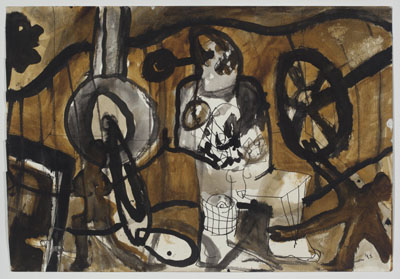 |
© 2011 Stephanie Simons |

|
In painting and poetry Barry Simons created images that were at once tangible and elusive, real and hallucinatory. His alchemy transformed the prosaic to the revelatory. Relentless, most often figural images, offer a mixture of moods and interests – angry, farcical, sexually ambivalent, and cryptic. Though his work has understandably been seen in “outsider” venues, it was not limited to the folk manner obsessions often common to that category. Events in Barry’s early life emerged latently in his art. One deceptive sepia drawing depicts a small figure sitting doll-like on a car seat. Knowing that Barry’s teenage friend died in a car he was driving reveals the painting as a tragedy. Though not responsible for the accident, his subsequent guilt haunts much of his work. This painting encapsulates many aspects of Barry’s interests and style. Here, over a mood establishing wash, layers of linear intrusions jostle for the viewer’s attention. Astride a couch-like car seat the anguished central figure grimaces with bared jack-o'-lantern teeth as a wind-up key pierces his head. Since Barry heard voices most of his life, this key hints at the many torments Barry endured. Keys open and confine. Keys start cars and offer explanations. Cars appear repeatedly in Barry Simons’ art. The rigid linear patterns common to many “outsider” drawings were not for Barry. His art shows a much greater range. In many paintings, blotchy background washes are surmounted by elegant linear formations, while lines varied in thickness corral amorphous wash areas into puzzling figures. In others, overlaying lines trap or correct embedded portraits or party crashing blob-like figures intrude from the edges. The humor of these uninvited blobs is that they introduce such an absurd difference in style. Like jazz, Barry’s paintings seem to invent themselves on the spot. Style is flexible and adapted to the need of conveying the image. |
 |
At each turn the art conjures a moment of the artist’s past into being. His parents, remembered from childhood, are frequently depicted. They appear as a belligerent, contesting couple or in regal attire converting the page to a domestic court. Barry, himself, may figure in images of glaring men with raised fists. He had learned to box as an adolescent. And then there are the interiors, rooms both domestic and institutional. Barry’s interiors, poignant as many a German expressionist’s, recall both his childhood home and, perhaps, his time confined for periods of mental instability. In one of these interiors, as a foil to the cryptic inhabitants, he has limned delicate table settings beneath a family portrait on a distant wall. These frequent details of ordinary life remind us that the expressive journey of the art is but an extension of the life we all know. After a life of writing poetry and making art, Barry succumbed to a massive brain hemorrhage in 2009. During his final days in a California hospital, he continued to talk principally of art. Throughout his years, he had managed to produce a body of work numbering in the thousands. Despite the complaints of displeased landlords, Barry smoked and painted into the depths of each of his nights. The record of his nocturnal journeys is now in various museums and private collections throughout the country. What has not yet been collected is in the possession of his surviving sister, Stephanie Simons. |